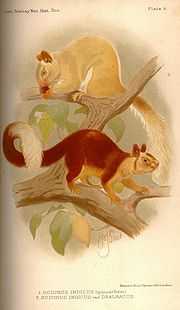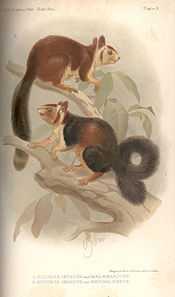Indian giant squirrel
| Indian Giant Squirrel | |
|---|---|
.jpg) | |
| Conservation status | |
| Scientific classification | |
| Kingdom: | Animalia |
| Phylum: | Chordata |
| Class: | Mammalia |
| Order: | Rodentia |
| Family: | Sciuridae |
| Genus: | Ratufa |
| Species: | R. indica |
| Binomial name | |
| Ratufa indica (Erxleben, 1777) | |
| Subspecies[2] | |
| |
 | |
| Indian giant squirrel range | |
The Indian giant squirrel, or Malabar giant squirrel, (Ratufa indica) is a large tree squirrel species genus Ratufa native to India. It is a large-bodied diurnal, arboreal, and herbivorous squirrel found in South Asia.[3] It is called शेकरू 'Shekru' in Marathi and is state animal of Maharashtra.
Description

The Ratufa indica has a conspicuous two-toned (and sometimes three-toned) color scheme.[4] The colors involved can be creamy-beige, buff, tan, rust, brown, or even a dark seal brown.[5] The underparts and the front legs are usually cream colored, the head can be brown or beige, however there is a distinctive white spot between the ears.[4] Adult head and body length varies around 14 inches (36 cm) and the tail length is approximately 2 ft (0.61 m). Adult weight - 2 kg (4.41 lb).[6]
Behavior
The Indian giant squirrel is an upper-canopy dwelling species, which rarely leaves the trees, and requires "tall profusely branched trees for the construction of nests."[3] It travels from tree to tree with jumps of up to 6 m (20 ft). When in danger, the Ratufa indica often freezes or flattens itself against the tree trunk, instead of fleeing.[4] Its main predators are the birds of prey and the leopard.[4] The Giant Squirrel is mostly active in the early hours of the morning and in the evening, resting in the midday. It is a shy, wary animal and not easy to discover.
Distribution
The species is endemic to deciduous, mixed deciduous, and moist evergreen forests of peninsular India, reaching as far north as the Satpura hill range of Madhya Pradesh (approx. 22° N).[3]
As can be seen in the range map of this species, it occupies isolated ranges that are widely separated from each other, thus producing conditions favorable for speciation. The squirrels found within each of these isolated ranges share distinctive color schemes, making it easy to identify which region a particular squirrel is from, as well as leading to the controversy (see section below on Subspecies) as to whether these different color schemed subspecies ought to be considered as unique species.[7]
Subspecies
There is some disagreement between biologists regarding how many subspecies belong to the Ratufa indica lineage. It is generally acknowledged that there are either four [2][8] or five[7][9] subspecies, depending on the source. This discrepancy is based on two separate lines of research, dating back to the 18th century. However, the most current data indicates that one of the subspecies (R. i. dealbata) claimed by those supporting the four subspecies stance has disappeared from its range in the province of Gujarat. Subsequently, it could also be argued that there are only three subspecies remaining.[2][7]
The different subspecies lists are indicated in the table below, along with some of the corresponding references supporting each one:
| Subspecies lists of Ratufa indica | ||||
| Five Subspecies List | Ellerman, 1961[9] | Four Subspecies List | Moore and Tate (1965)[10] | |
|---|---|---|---|---|
| R. i. indica | Erxleben, 1777[11] | R. i. indica | Erxleben, 1777[11] | |
| R. i. centralis | Ryley, 1913[12] | R. i. centralis | Ryley, 1913[12] | |
| R. i. maxima | Schreber, 1784[13] | R. i. maxima | Schreber, 1784[13] | |
| R. i. superans | Ryley, 1913[12] | R. i. dealbata | Blanford, 1897[14] (considered extinct) | |
| R. i. bengalensis | Blanford, 1897[14] | |||
To further complicate things, there is yet still more disagreement about the classification of this species' subspecies. Some biologists maintain that there should be up to eight subspecies considered, due to the fact that there are eight different distinct color schemes found among this species, and these are based on geographical ranges with intervening areas that separate the squirrel populations from one another.[15]
Finally, there is still another point of disagreement in which some biologists consider that some of these subspecies ought to be elevated to be considered their own species. In this case, the general agreement would be that there would be four or five species created out of Ratufa indica's subspecies.[7]
To sum this up, this species either has three, four, five or eight subspecies, or it may end up having none. This irresolution has been going on for over a century, and there is no indication that it will be resolved anytime soon. It is important to note, when dealing with this species, that there is this disagreement, and even if it is resolved in the future, there will still be much confusion within the literature that has already been published. So, it is good to keep this in mind when reading or studying this species, in order to avoid potential confusion.
Here are some brief descriptions of some of the color schemes and subspecies:
- Ratufa indica indica (Erxleben, 1777)
- The rust and buff Ratufa indica centralis (Ryley, 1913) of the tropical dry deciduous forests of Central India, near Hoshangabad.[5]
- The buff and tan Ratufa indica dealbata (Figure 1, top) of the tropical moist deciduous forests of the Surat Dangs.
- The seal brown, tan, and beige (and darkest) Ratufa indica maxima (Schreber, 1784) (Figure 2, bottom) of the tropical wet evergreen forest of Malabar.
- Ratufa indica superans (Ryley, 1913)
- the dark brown, tan and beige (and largest), Ratufa indica bengalensis (Blanford, 1897) (Figure 2, top) of the tropical semi-evergreen forests east of the Brahmagiri mountains in Kodagu extending up to the Bay of Bengal coast of Orissa;
- It is also seen (dark brown) on Tirumala hills at Tirupati both in the wild and at Sri Venkateswara Zoological Park, Andhra Pradesh.
 Indian giant squirrel subspecies Ratufa indicus dealbatus (top) and Ratufa indicus typicus (bottom). |
 |
 Indian giant squirrel subspecies Ratufa indicus bengalensis (top) and Ratufa indicus malabaricus (bottom). |
The table below lists the four recognized subspecies (based on Thorington & Hoffmann 2005) of Ratufa indica, along with any synonyms associated with each subspecies:[2]
| Subspecies | Authority | Synonyms |
|---|---|---|
| R. i. indica | Erxleben (1777) | bombaya, elphinstoni, purpureus, superans |
| R. i. centralis | Ryley (1913) | none |
| R. i. dealbata | Blanford (1897) | none |
| R. i. maxima | Schreber (1784) | bengalensis, malabarica |
Family life
The Indian Giant Squirrel lives alone or in pairs. They build large globular nests of twigs and leaves, placing them on thinner branches where large predators can't get to them. These nests become conspicuous in deciduous forests during the dry season. An individual may build several nests in a small area of forest which are used as sleeping quarters, with one being used as a nursery.
Reproduction
Captive breeding of the Malayan giant squirrel, a close relative has indicated births in March, April, September and December. The young weigh 74.5 gms at birth and have a length of 27.3 cms. In Canara, the Indian Giant Squirrel has been spotted with young in March.
Bhimashankar Wildlife Sanctuary
Bhimashankar Wildlife Sanctuary was created in the Ambegaon and Khed talukas of Pune District, in the Western Indian state of Maharashtra in order mainly to protect the habitat of the Indian giant squirrel, its area is 130 km2 and is a part of the Western Ghats (Sahyadri Ranges). This sanctury was created in 1984.[16]
References
- ↑ Rajamani, N., Molur, S. & Nameer, P. O. (2010). Ratufa indica. In: IUCN 2008. IUCN Red List of Threatened Species. Retrieved 22 June 2012.
- ↑ 2.0 2.1 2.2 2.3 Thorington, R.W., Jr.; Hoffmann, R.S. (2005). "Ratufa indica". In Wilson, D.E.; Reeder, D.M. Mammal Species of the World: a taxonomic and geographic reference (3rd ed.). The Johns Hopkins University Press. pp. 754–818. ISBN 0-8018-8221-4. OCLC 26158608.
- ↑ 3.0 3.1 3.2 (Datta & Goyal 1996, p. 394)
- ↑ 4.0 4.1 4.2 4.3 Tritsch 2001, pp. 132–133
- ↑ 5.0 5.1 Prater 1971, pp. 24–25
- ↑ Prater 1971, p. 198
- ↑ 7.0 7.1 7.2 7.3 Rajamani, Nandini; Sanjay Molur & P. Ommer Nameer (2008). "Ratufa indica". IUCN Red List of Threatened Species. Version 2009.2. International Union for Conservation of Nature and Natural Resources (IUCN). Retrieved 24 February 2010.
- ↑ Corbet, Gordon Barclay; Hill, John Edwards (1992). The mammals of the Indomalayan Region:a systematic review. Oxford: Oxford University Press. ISBN 0-19-854693-9. OCLC 25281229.
- ↑ 9.0 9.1 Ellerman, John R. (1961). Roonwall, M.L., ed. Rodentia: variation. Fauna of India including Pakistan, Burma and Ceylon. Mammalia. 3 (in 2 parts) (2nd ed.). Delhi: Manager of Publications. pp. 483–884. OCLC 78803208.
- ↑ Moore, J.C.; Tate, G.H.H. (1965). "A study of the diurnal squirrels, Sciurinae, of the Indian and Indo-Chinese subregion". Fieldiana Zoology (Chicago, Illinois: Field Museum of Natural History; Chicago Natural History Museum) 48. ISSN 0015-0754. OCLC 1426915.
- ↑ 11.0 11.1 Erxleben, Johann Christian Polykarp (1777). Systema regni animalis per classes, ordines, genera, species, varietates cum synonymia et historia animalium. Classis I. Mammalia. [Animal kingdom system by class, order, genus, species, varieties with synonyms and animals' history. Class I. Mammalia.] (in Latin) 42. Leipzig, Germany: Impensis Weygandianis. OCLC 14843832.
- ↑ 12.0 12.1 12.2 Ryley, Kathleen V. "Scientific results from the mammals survey". The Journal of the Bombay Natural History Society (Mumbai, India: Bombay Natural History Society) 22: 434–443. ISSN 0006-6982. OCLC 1536710.
- ↑ 13.0 13.1 Schreber, Johann Christian Daniel von (1792) [Chapter on The Squirrel first published in 1784]. "Der Springer" [The Squirrel]. Die Säugthiere in Abbildungen nach der Natur, mit Beschreibungen [The Säugthiere in illustrations after nature, with descriptions] (in German) 3. Erlangen: Wolfgang Walther. OCLC 16860541.
- ↑ 14.0 14.1 Blanford, William Thomas (1897). "The large Indian squirrel (Sciurus indicus) and its local races or subspecies". The Journal of the Bombay Natural History Society (Mumbai, India: Bombay Natural History Society) 11: 298–305. ISSN 0006-6982. OCLC 1536710.
- ↑ Daniel, J.C. (1952). "Races of the Indian giant squirrel (Ratufa indica)". Journal of the Bombay Natural History Society (Mumbai: Bombay Natural History Society) 50: 469–474. ISSN 0006-6982. OCLC 1536710.
- ↑ Deo, Sharmila. "The Environment Education Programme in Bhimashankar Wildlife Sanctuary". Kalpavriksh Environmental Action Group. Retrieved 6 February 2011.
Bibliography
- Blanford, W. T. (1897), "The large Indian squirrel (Sciurus indicus erx.) and its local races and sub-species", Journal of the Bombay Natural History Society 11 (2): 298–305
- Borges, Renee M. (1993), "Figs, Malabar Giant Squirrels, and Fruit Shortages Within Two Tropical Indian Forests", Biotropica 25 (2): 183–190, doi:10.2307/2389182
- Datta, Aparajita; Goyal, S. P. (1996), "Comparison of Forest Structure and Use by the Indian Giant Squirrel (Ratufa indica) in Two Riverine Forests of Central India", Biotropica 28 (3): 394–399, doi:10.2307/2389203
- Moore, Joseph Curtis (1960), "Squirrel Geography of the Indian Subregion", Systematic Zoology 9 (1): 1–17, doi:10.2307/2411536
- Prater, S. H. (1971), The book of Indian Animals, Mumbai: Bombay Natural History Society and Oxford University Press. Pp. xxiii, 324, 28 color plates by Paul Barruel., ISBN 0-19-562169-7
- Somanathan, Hema; Mali, Subhash; Borges, Renee M. (2007), "Arboreal larder-hoarding in tropical Indian giant squirrel Ratufa indica", Ecoscience 14 (2): 165–169, doi:10.2980/1195-6860(2007)14[165:alitti]2.0.co;2
- Tritsch, Mark F. (2001), Wildlife of India, London: Harper Collins Publishers. Pp. 192, ISBN 0-00-711062-6
External links
| Wikimedia Commons has media related to Ratufa indica. |
- Indian giant squirrel (Ratufa indica) - Arkive.org page on this squirrel, including a video clip of the animal in the wild.
| ||||||||||||||||||||||
